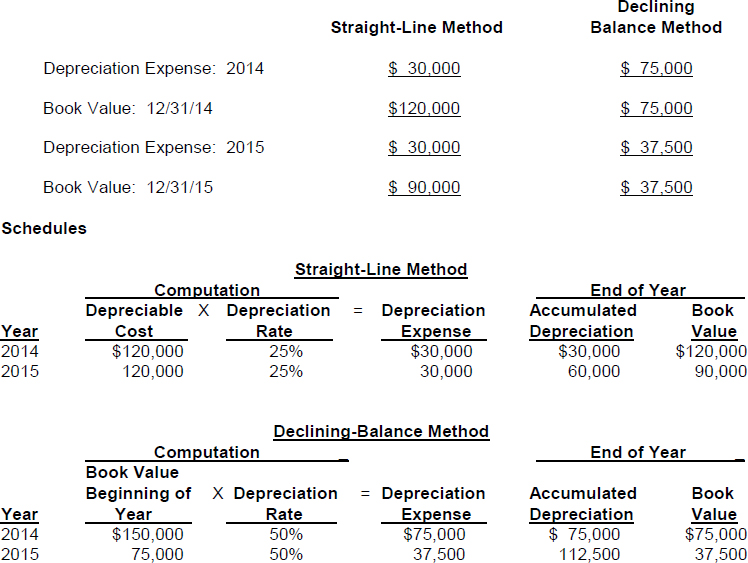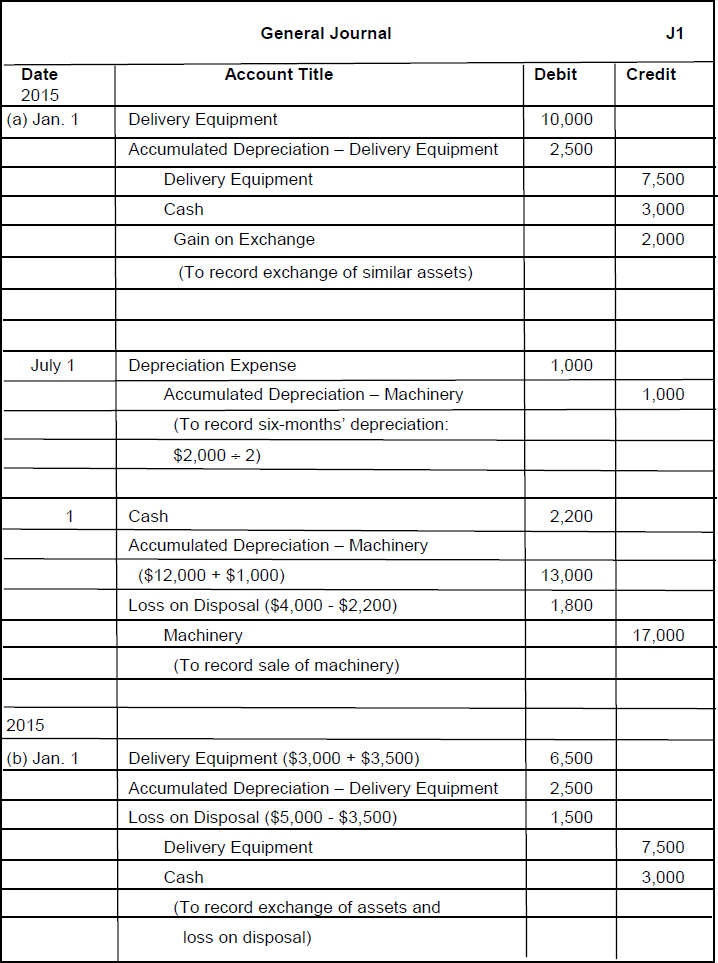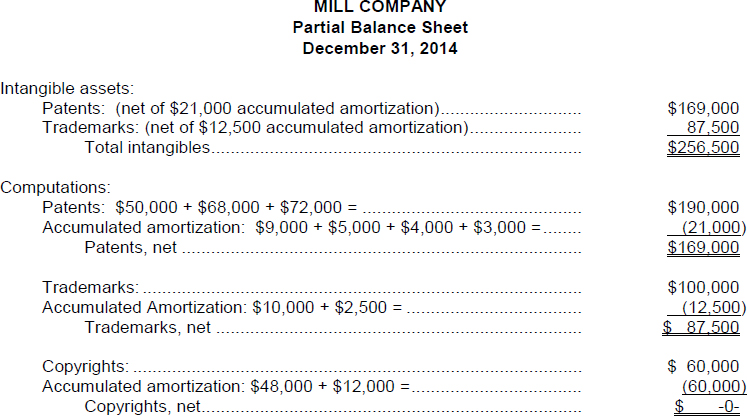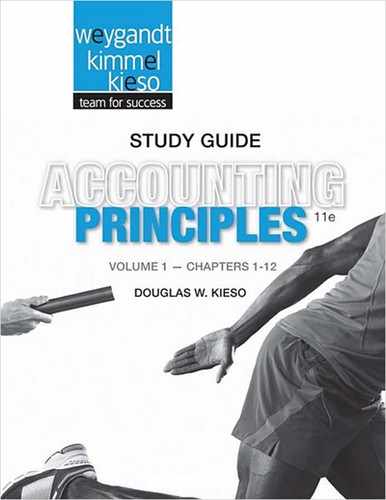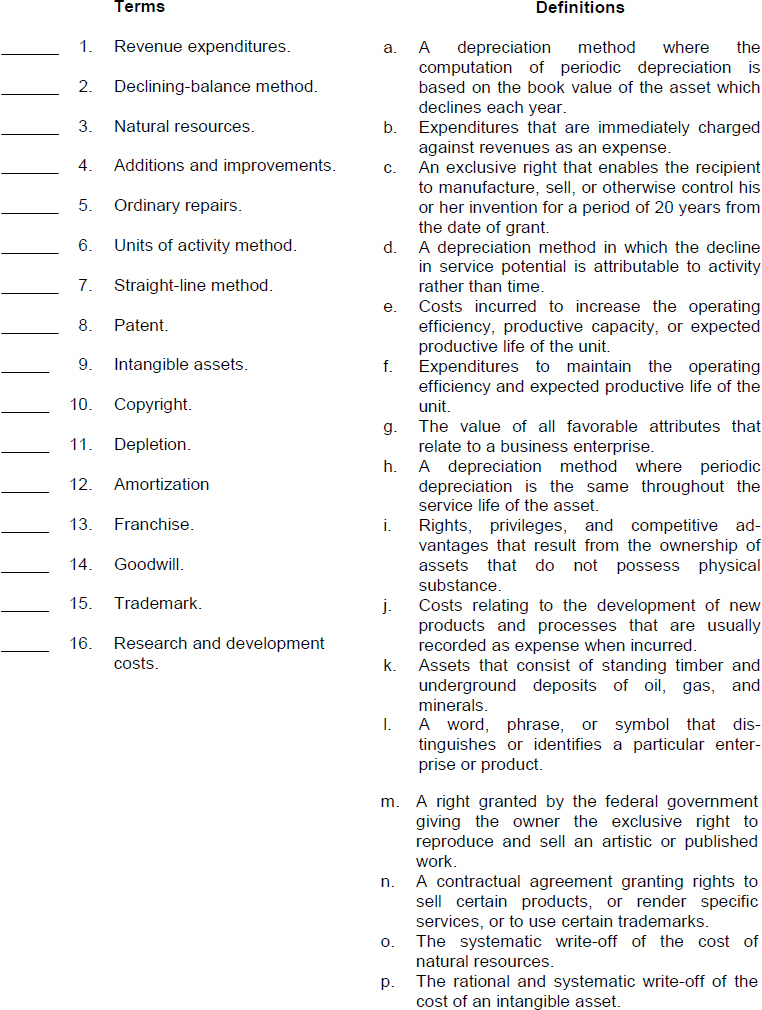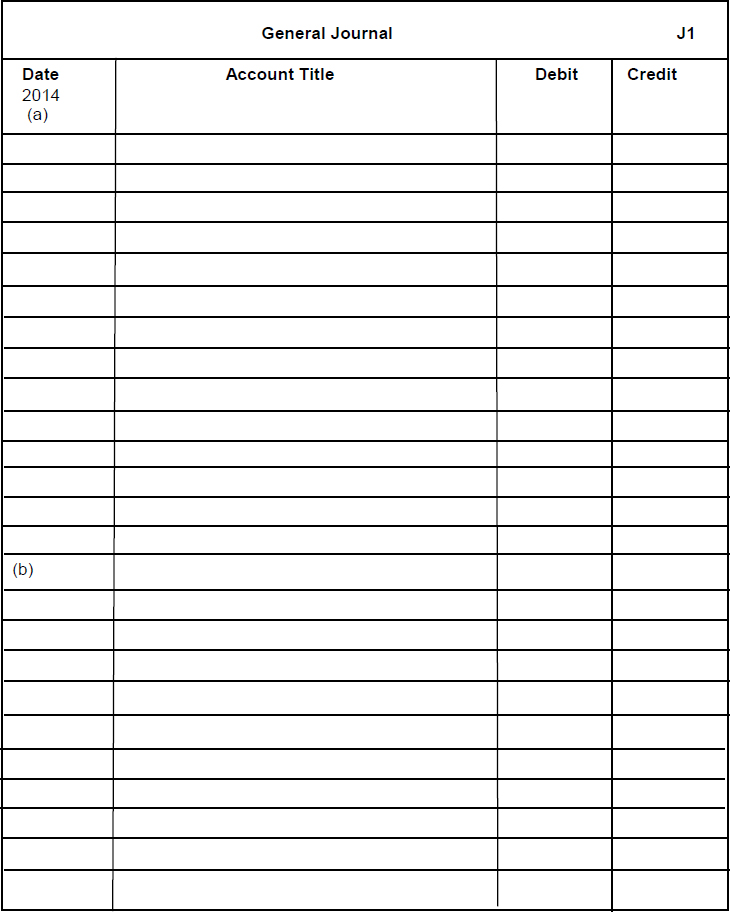Chapter 10
PLANT ASSETS, NATURAL RESOURCES, AND INTANGIBLE ASSETS
CHAPTER LEARNING OBJECTIVES
After studying this chapter, you should be able to:
1. Describe how the historical cost principle applies to plant assets.
2. Explain the concept of depreciation and how to compute it.
3. Distinguish between revenue and capital expenditures, and prepare the entries for each.
4. Explain how to account for the disposal of a plant asset.
5. Compute periodic depletion of natural resources.
6. Explain the basic issues related to accounting for intangible assets.
7. Indicate how plant assets, natural resources, and intangible assets are reported.
*8. Explain how to account for the exchange of plant assets.
*9. Compare the accounting procedures for long-lived assets under GAAP and IFRS.
Note: All asterisked (*) items relate to material contained in the Appendix to the chapter.
![]()
PREVIEW OF CHAPTER 10
In this chapter, we explain the application of the cost principle of accounting to plant assets, natural resources and intangible assets. We also describe the methods that may be used to allocate an asset's cost over its useful life. In addition, the accounting for expenditures incurred during the useful life of assets is discussed. The organization and content of this chapter are as follows:

![]()
Plant Assets
- (L.O. 1) Plant assets are resources that have a physical substance (a definite size and shape), are used in the operations of a business and are not intended for sale to customers. They are also called property, plant, and equipment; plant and equipment; or fixed assets.
Cost of Plant Assets
2. Plant assets are recorded at cost in accordance with the historical cost principle of accounting. Cost consists of all expenditures necessary to (1) acquire the asset, and (2) make it ready for its intended use.
3. The cost of land includes the cash purchase price, closing costs such as title and attorney's fees, real estate brokers' commissions, and accrued property taxes and other liens on the land assumed by the purchaser. All necessary costs incurred in making land ready for its intended use are debited to the Land Account.
4. Land improvements are structural additions made to land, such as driveways, parking lots, fences, landscaping, and underground sprinklers. The cost of land improvements includes all expenditures needed to make the improvements ready for their intended use.
5. The cost of buildings includes all necessary costs related to the purchase or construction of a building:
a. When a building is purchased, such costs include the purchase price, closing costs, and real estate broker's commission.
b. Costs to make the building ready for its intended use include expenditures for remodeling and replacing or repairing the roof, floors, wiring, and plumbing.
c. When a new building is constructed, cost consists of the contract price plus payments for architects' fees, building permits, interest payments during construction, and excavation costs.
6. The cost of equipment consists of the cash purchase price, sales taxes, freight charges, and insurance paid by the purchaser during transit. Cost includes all expenditures required in assembling, installing, and testing the unit. Recurring costs such as licenses and insurance are expensed as incurred.
Depreciation
7. (L.O. 2) Depreciation is the process of allocating to expense the cost of a plant asset over its useful (service) life in a rational and systematic manner.
a. The cost allocation is designed to provide for the proper matching of expenses with revenues in accordance with the expense recognition principle.
b. During an asset's life, its usefulness may decline because of wear and tear or obsolescence.
c. Recognition of depreciation does not result in the accumulation of cash for the replacement of the asset.
8. Three factors that affect the computation of depreciation are (1) cost, (2) useful life, and (3) salvage value.
9. (L.O. 2) Three methods of recognizing depreciation are (a) straight-line, (b) units of activity, and (c) declining-balance.
a. Each method is acceptable under generally accepted accounting principles.
b. Management selects the method that is appropriate in the circumstances.
c. Once a method is chosen, it should be applied consistently.
Straight-Line Method
10. Under the straight-line method depreciation is the same for each year of the asset's useful life.
a. The formula for computing annual depreciation expense is:
Depreciable Cost ÷ Useful Life (in years) = Depreciation Expense
b. To illustrate the computation, assume that the Benson Company purchased a delivery truck for $11,000 on January 1 with an estimated salvage value of $1,000 at the end of its four-year service life. Annual depreciation is $2,500 [($11,000 - $1,000 ÷ 4)].
c. The straight-line method predominates in practice.
d. This method is simple to apply and it matches expenses and revenues appropriately when the use of the asset is reasonably uniform throughout the service life.
Units-of-Activity Method
11. Under the units-of-activity method, service life is expressed in terms of the total units of production or expected use from the asset, rather than time.
a. The formulas for computing depreciation expense are:
(1) Depreciable Cost ÷ Total Units of Activity = Depreciation Cost per Unit
(2) Depreciation Cost per Unit X Units of Activity During the Year = Depreciation Expense
b. To illustrate the computation, assume that Benson Company expects to drive the truck purchased in (10b) above for 100,000 miles and that 30,000 miles are driven in the first year. Depreciation for the first year is $3,000.
(1) $10,000 ÷ 100,000 = $.10 per mile.
(2) $.10 X 30,000 = $3,000.
c. In using this method, it is often difficult to make a reasonable estimate of total activity.
d. When the productivity of an asset varies significantly from one period to another, this method results in the best matching of expenses with revenues.
12. The declining-balance method produces a decreasing annual depreciation expense over the useful life of the asset.
a. The formula for computing depreciation expense is:
Book Value at Beginning of Year X Declining Balance Rate = Depreciation Expense
b. To illustrate the computation, assume that Benson Company uses a declining-balance rate that is double the straight-line rate of 25%. Depreciation in the first year is $5,500 ($11,000 X 50%). Depreciation in the second year is $2,750 [($11,000 - $5,500) X 50%].
c. Under this method, the depreciation rate remains constant from year to year, but the book value to which the rate is applied declines each year.
d. This method is compatible with the matching principle because the higher depreciation in early years is matched with the higher benefits received in these years.
13. Taxpayers must use on their tax returns either the straight-line method or a special accelerated depreciation method called the Modified Accelerated Cost Recovery System (MACRS).
Revising Periodic Depreciation
14. (L.O. 2) If wear and tear or obsolescence indicate that annual depreciation is inadequate or excessive, a change in the periodic amount should be made.
a. When a change is made, (1) there is no correction of previously recorded depreciation expense, and (2) depreciation expense for current and future years is revised.
b. To determine the new annual depreciation expense, the depreciable cost at the time of the revision is divided by the remaining useful life.
Expenditures During Useful Life
15. (L.O. 3) Ordinary repairs are expenditures to maintain the operating efficiency and expected productive life of the plant asset. They are debited to Repairs Expense as incurred and are often referred to as revenue expenditures.
16. Additions and improvements are costs incurred to increase the operating efficiency, productive capacity, or expected useful life of the plant asset. These expenditures are usually material in amount and occur infrequently during the period of ownership.
17. Capital expenditures increase the company's investment in productive facilities. These expenditures include additions and improvements.
Plant Asset Disposals
18. (L.O. 4) Plant assets may be disposed of by (a) retirement, (b) sale, or (c) exchange.
19. At the time of disposal, it is necessary to determine the book value of the plant asset.
a. If the disposal occurs during the year, depreciation for the fraction of the year to the date of disposal must be recorded.
b. The book value is then eliminated by debiting the Accumulated Depreciation account for the total depreciation to the date of disposal and crediting the asset account for the cost of the asset.
20. In accounting for a disposal by retirement,
a. if the asset is fully depreciated, the entry is a debit to Accumulated Depreciation and a credit to the plant asset account.
b. if the asset is retired before it is fully depreciated and no scrap or salvage value is received, a loss on disposal occurs.
c. the loss on disposal is reported in the Other Expenses and Losses section of the income statement.
Sale of Plant Assets
21. In a disposal by sale, the book value of the asset is compared with the proceeds received from the sale.
a. If the proceeds of the sale exceed the book value, a gain on disposal occurs which is reported in the Other Revenues and Gains section of the income statement.
b. If the proceeds of the sale are less than the book value of the asset, a loss on disposal occurs which is reported in the Other Expenses and Losses section of the income statement.
Natural Resources
22. (L.O. 5) Natural resources consist of standing timber and underground deposits of oil, gas, and minerals. These assets are frequently called wasting assets.
Acquisition Cost
23. The acquisition cost of a natural resource is the price needed to acquire the resource and prepare it for its intended use.
Depletion
24. Depletion is the systematic write-off of the cost of natural resources. The units of activity method is generally used to compute depletion because periodic depletion is generally a function of the units extracted during the year. The formulas for computing depletion expense are:
a. Total Cost minus Salvage Value ÷ Total Estimated Units = Depletion Cost per Unit.
b. Depletion Cost per Unit X Number of Units Extracted and Sold = Depletion Expense.
25. To record depletion expense, Depletion Expense is debited and a contra asset account, Accumulated Depletion, is credited.
a. Depletion expense is reported as a cost of producing the product.
b. Accumulated Depletion is deducted from the cost of the natural resource in the balance sheet.
Intangible Assets
26. (L.O. 6) Intangible assets are rights, privileges, and competitive advantages that result from the ownership of assets that do not possess physical substance. Intangibles may arise from government grants, acquisition of another business, and private monopolistic arrangements.
27. In general, accounting for intangible assets parallels the accounting for plant assets. Intangible assets are (a) recorded at cost, (b) cost is written off over useful life in a rational and systematic manner, assuming the useful life is limited, and (c) at disposal, book value is eliminated and gain or loss, if any, is recorded. If the life of the intangible is indefinite, the cost of the intangible should not be allocated.
28. Differences between the accounting for intangible assets and the accounting for plant assets include:
a. The systematic write-off of an intangible asset is referred to as amortization.
b. To record amortization, Amortization Expense is debited and the specific intangible asset is credited.
c. Amortization is typically computed on a straight-line basis.
Patents
29. A patent is an exclusive right issued by the U.S. Patent Office that enables the recipient to manufacture, sell, or otherwise control his or her invention for a period of twenty years from the date of grant.
a. The initial cost of a patent is the cash or cash equivalent price paid when the patent is acquired.
b. When legal costs are incurred in successfully defending the patent, they are added to the Patent account and amortized over the remaining useful life of the patent.
c. The cost of the patent should be amortized over its legal life (20 years) or useful life, whichever is shorter.
Copyrights
30. Copyrights are granted by the federal government, giving the owner the exclusive right to reproduce and sell an artistic or published work.
Trademark or Trade name
31. A trademark or trade name is a word, phrase, jingle, or symbol that distinguishes or identifies a particular enterprise or product.
Franchises
32. A franchise is a contractual arrangement under which the franchisor grants the franchisee the right to sell certain products, to render specific services, or to use certain trademarks or trade names, usually within a designated geographical area. Another type of franchise, commonly referred to as a license or permit, is entered into between a governmental body and a business enterprise and permits the enterprise to use public property in performing its services.
Goodwill
33. Goodwill is the value of all favorable attributes that relate to a business enterprise such as exceptional management, skilled employees, high-quality products, fair pricing policies, and harmonious relations with labor unions.
a. Goodwill can be identified only with the business as a whole.
b. Goodwill is recorded only when there is an exchange transaction that involves the purchase of an entire business.
c. When an entire business is purchased, goodwill is the excess of cost over the fair market value of the net assets (assets less liabilities) acquired.
34. Goodwill is not amortized because it is considered to have an indefinite life, but it is reviewed for impairment.
Research and Development
35. Research and development costs are costs that are spent on developing new products and processes. Such costs are usually recorded as an expense when incurred.
Financial Statement Presentation
36. (L.O. 7) In the balance sheet, plant assets and natural resources are usually combined under Property, Plant, and Equipment and intangibles are shown separately under Intangible Assets.
a. There should be disclosure of the balances in the major classes of assets and accumulated depreciation of major classes of assets or in total.
b. Depreciation and amortization methods used should be described and the amount of depreciation and amortization expense for the period disclosed.
Exchanges of Plant Assets
*37. (L.O. 8) An exchange of similar assets involves assets of the same type. In this type of exchange, the new asset performs the same function as the old asset. The accounting depends on whether there is a gain or loss on the old asset.
a. When a gain occurs in the exchange of similar assets:
(1) The acquisition cost of the new asset is equal to the fair value of the old asset exchanged plus any cash or other consideration given up.
(2) The gain or loss is the difference between the fair value and the book value of the asset given up.
b. When a loss occurs in the exchange of similar assets, the loss is recognized immediately—it is not deferred.
A Look at IFRS
*38. (L.O. 9) IFRS follows most of the same principles as GAAP in the accounting for property, plant, and equipment; the definition for plant assets is essentially the same, they both follow the cost principle, both capitalize interest costs during construction, both capitalize, all direct costs in self constructed assets, both view depreciation as an allocation of cost over an asset's useful life, and both permit the same depreciation methods (e.g., straight-line, accelerated, and units-of-activity).
*39. A major difference between GAAP and IFRS is that IFRS requires component depreciation. Component depreciation specifies that any significant parts of a depreciable asset that have different estimated useful lives should be separately depreciated. Component depreciation is allowed under GAAP but is seldom used.
*40. IFRS uses the term residual value rather than salvage value.
*41. IFRS allows companies to revalue plant assets to fair value at the reporting date. If revaluation is used, it must be applied to all assets in a class of assets. Assets that are experiencing rapid changes must be revalued on an annual basis, otherwise less frequent revaluation is acceptable.
*42. Under both GAAP and IFRS changes in the depreciation method used and changes in useful life are handled in current and future periods. The accounting for subsequent expenditures, plant asset disposals, the initial costs to acquire natural resources, and the defining of intangible assets are all essentially the same under IFRS and GAAP.
*43. The difference between GAAP and IFRS regarding research and development costs are that under IFRS costs in the development phase are capitalized as Development Costs once technological feasibility is achieved.
*44. IFRS permits revaluation of intangible assets (except for goodwill). GAAP prohibits revaluation of intangible assets.
*45. IFRS requires an impairment test of each reporting date for plant assets and intangibles and records an impairment if the asset's carrying amount exceeds its recoverable amount.
*46. IFRS allows reversal of impairment losses when there has been a change in economic conditions or in the expected use of the asset. Under GAAP, impairment losses cannot be reversed for assets to be held and used; the impairment loss results in a new cost basis for the asset.
![]()
![]()

REVIEW QUESTIONS AND EXERCISES
TRUE—FALSE
Indicate whether each of the following is true (T) or false (F) in the space provided.
![]()
MULTIPLE CHOICE
Circle the letter that best answers each of the following statements.
- (L.O. 1) A term which is not synonymous with property, plant, and equipment is:
- plant assets.
- fixed assets.
- intangible assets.
- long-lived tangible assets.
- (L.O. 1) Plant assets are often subdivided into four groups. Which of the following would not be classified as a plant asset?
- Land.
- Land improvements.
- Supplies.
- Buildings.
- (L.O. 1) Plato Company acquired land with a purchase price of $150,000 plus attorney's fee $6,000, demolition and removal costs of an old building $4,000, and grading and filling the land $3,000. The land should be recorded at:
- $137,000.
- $150,000.
- $157,000.
- $163,000.
- (L.O. 1) Land improvements do not include:
- building sites.
- driveways.
- parking lots.
- fencing.
- (L.O. 1) Schopenhauer Company purchased a delivery truck and incurred the following costs:

What amount should be recorded as the cost of the delivery truck?
- $15,750.
- $16,350.
- $16,425.
- $17,125.
- (L.O. 2) The factor that is not relevant in computing depreciation is:
- Replacement value.
- Cost.
- Salvage value.
- Useful life.
- (L.O. 2) Using the straight-line method, depreciation expense is calculated with the formula:
- (Cost ÷ Useful life) - Salvage value.
- (Cost + Salvage value) ÷ Useful life.
- (Cost - Salvage value) ÷ Useful life.
- (Cost ÷ Useful life) + Salvage value.
- (L.O. 2) Bruno Company purchased equipment on January 1, 2014 at a total invoice cost of $280,000; additional costs of $5,000 for freight and $25,000 for installation were incurred. The equipment has an estimated salvage value of $10,000 and an estimated useful life of five years. The amount of accumulated depreciation at December 31, 2015 if the straight-line method of depreciation is used is:
- $108,000.
- $110,000.
- $120,000.
- $124,000.
- (L.O. 2) Spinoza Enterprises purchased a truck for $27,000 on January 1, 2014. The truck will have an estimated salvage value of $2,000 at the end of five years. Using the units of activity method, the accumulated depreciation at December 31, 2015 can be computed by the following formula:
- ($27,000 ÷ Total estimated activity) X Units of activity for 2015.
- ($25,000 ÷ Total estimated activity) X Units of activity for 2015.
- ($27,000 ÷ Total estimated activity) X Units of activity for 2014 and 2015.
- ($25,000 ÷ Total estimated activity) X Units of activity for 2014 and 2015.
- (L.O. 2) Nietzsche Company purchased a machine on January 1, 2014, for $350,000. The machine has an estimated useful life of five years and a salvage value of $50,000. The machine is being depreciated using the double-declining balance method. The book value at December 31, 2015 is:
- $126,000.
- $158,000.
- $170,000.
- $224,000.
- (L.O. 2) Santayana Company purchased a machine on January 1, 2012, for $8,000 with an estimated salvage value of $2,000 and an estimated useful life of 8 years. On January 1, 2014, Santayana decides the machine will last 12 years from the date of purchase. The salvage value is still estimated at $2,000. Using the straight-line method the new annual depreciation will be:
- $450.
- $500.
- $600.
- $667.
- (L.O. 3) Which of the following would be considered an ordinary repair?
- Constructing a new wing on a building.
- A major motor overhaul of a new truck.
- Painting of buildings.
- Replacing a stairway with an escalator.
- (L.O. 3) Improvements are:
- revenue expenditures.
- debited to an appropriate asset account when they increase useful life.
- debited to accumulated depreciation when they do not increase useful life.
- debited to an appropriate asset account when they do not increase useful life.
- (L.O. 4) Which of the following is an example of a plant asset disposal?
- Retirement.
- Sale.
- Exchange.
- All of the above are examples.
- (L.O. 4) A plant asset cost $27,000 when it was purchased on January 1, 2007. It was depreciated by the straight-line method based on a 9-year life with no salvage value. On June 30, 2014, the asset was discarded with no cash proceeds. What gain or loss should be recognized on the retirement?
- No gain or loss.
- $6,000 loss.
- $4,500 loss.
- $3,000 gain.
Use the following information for questions 16 and 17:
On May 1, 2014, Bentham Company sells office furniture for $60,000 cash. The office furniture originally cost $150,000 when purchased on January 1, 2007. Depreciation is recorded by the straight-line method over 10 years with a salvage value of $15,000.
16. (L.O. 2) What depreciation expense should be recorded on this asset in 2014?
a. $4,500.
b. $5,000.
c. $6,750.
d. $13,500.
17. (L.O. 4) What gain should be recognized on the sale?
a. $4,500.
b. $9,000.
c. $9,500.
d. $18,000.
18. (L.O. 4) On January 1, Averroes Company sold a machine that had a book value of $7,500 for $8,000 cash. The entry by Averroes Company on January 1, will include a:
a. debit to Loss on Disposal.
b. credit to Loss on Disposal.
c. debit to Gain on Disposal.
d. debit to Cash.
19. (L.O. 5) Natural resources include all of the following except:
a. standing timber.
b. land improvements.
c. oil deposits.
d. mineral deposits.
20. (L.O. 5) The entry to record depletion expense:
a. decreases owner's equity and assets.
b. decreases net income and increases liabilities.
c. decreases assets and liabilities.
d. decreases assets and increases liabilities.
21. (L.O. 5) Abelard Company expects to extract 15 million tons of coal from a mine that cost $25 million. If no salvage value is expected, and 3,000,000 tons are mined and sold in the first year, the entry to record depletion in the first year will include a:
a. debit to Accumulated Depletion of $3,000,000.
b. credit to Depletion Expense of $5,000,000.
c. debit to Depletion Expense of $5,000,000.
d. credit to Accumulated Depletion of $1,800,000.
22. (L.O. 6) All of the following are intangible assets except:
a. franchises.
b. copyrights.
c. accounts receivable.
d. goodwill.
23. (L.O. 6) A purchased patent has a legal life of 20 years. It should be:
a. expensed in the year of acquisition.
b. amortized over 20 years regardless of its useful life.
c. amortized over its useful life if less than 20 years.
d. not amortized.
24. (L.O. 6) Eloise Company incurred $350,000 of research and development costs in its laboratory to develop a patent granted on January 1, 2014. On July 31, 2014, Eloise paid $52,000 for legal fees in a successful defense of the patent. The total amount debited to Patents through July 31, 2014, should be:
a. $350,000.
b. $52,000.
c. $402,000.
d. $298,000.
25. (L.O. 6) Goodwill from the acquisition of a business enterprise:
a. should be expensed in the year of acquisition.
b. is an asset that is not subject to amortization.
c. is not an intangible asset.
d. is granted by the federal government.
*26. (L.O. 8) Voltaire Company exchanged an old machine, with a book value of $53,000 and a fair value of $49,000, and paid $7,000 cash for a similar used machine. At what amount should the machine acquired in the exchange be recorded on the books of Voltaire?
a. $49,000.
b. $53,000.
c. $56,000.
d. $60,000.
![]()
Match each term with its definition by writing the appropriate letter in the space provided.
![]()
EXERCISES
EX. 10-1 (L.O. 1 and 5) During 2014, Bergson Company had the following plant asset transactions.
| Jan. 1 | Purchased a bus for company tours. The bus had a purchase price of $23,000 plus costs of $500 for delivery charges, $250 for insurance during transit to the company, $700 for painting and lettering, $300 for sales tax, $30 for motor vehicle license, and $800 for accident insurance for two years. |
| July 1 | Purchased a factory machine by making a $500 down payment and signing a $2,500 1-year, 10% note. |
Instructions
Journalize the transactions. (Omit explanations.)
EX. 10-2 (L.O. 3) On January 1, 2014, Dewey Company purchased a mainframe computer for $150,000. The computer is estimated to have a $30,000 salvage value after its four-year useful life.
Instructions
(a) Fill in the appropriate amounts concerning the depreciation on the computer for the depreciation methods identified below.
(b) Show the depreciation schedules for each method for the years 2014 and 2015.

EX. 10-3 (L.O. 6 and *10) During 2015, the Leibniz Company had the following plant asset transactions.
| Jan. 1 | Exchange a delivery truck and $3,000 of cash for another delivery truck from Goethe Company. The Leibniz truck had a book value of $5,000 (accumulated depreciation of $2,500) and a fair market value of $7,000. The Goethe truck had a book value of $4,000 (accumulated depreciation of $9,500). The exchange has commercial substance. |
| July 1 | Sold machinery costing $17,000 for $2,200 cash. The machinery had accumulated depreciation of $12,000 at December 31, 2014, based on annual depreciation of $2,000 per year. |
Instructions
(a) Journalize the plant asset transactions.
(b) Assume the same facts in the January 1 exchange except that the fair value of the Leibniz truck was $3,500. Journalize this exchange transaction.
EX 10-4 (L.O. 8) On December 31, 2013, the intangible asset section of Mill Company's balance sheet was:

Mill owns two patents, one purchased for $50,000 on 1/1/13 with a total useful life of 10 years, and the other purchased for $68,000 on 1/1/13 with a total useful life of 17 years. The trademark was obtained on 1/1/10 for $100,000. The copyrights were also capitalized on 1/1/10 at a cost of $60,000. During 2014, Mill purchased a patent on July 1 at a cost of $72,000. This patent has a total useful life of 12 years from 7/1/14.
Instructions
Prepare the December 31, 2014 intangible asset section of Mill Company's balance sheet.

![]()
SOLUTIONS TO REVIEW QUESTIONS AND EXERCISES
TRUE-FALSE
| 1. (T) | |
| 2. (F) | Land is a plant asset that is not depreciated over its useful life. |
| 3. (F) | The cost of tearing down the old building should be debited to Land. |
| 4. (F) | The cost of driveways and parking lots is debited to Land Improvements. |
| 5. (T) | |
| 6. (F) | The cost of equipment includes the cash price, freight charges, expenditures required in assembling, etc. Motor vehicle licenses and accident insurance are expensed as incurred because they represent annual recording expenditures. |
| 7. (F) | Recognition of depreciation permits a matching of expenses and revenues, but does not result in the accumulation of cash for the replacement of the asset. |
| 8. (F) | Under the straight-line method, depreciation is the same for each year of service life of the asset. |
| 9. (F) | Under the units of activity method the decline in service potential is attributed to activity rather than time. |
| 10. (T) | |
| 11. (T) | |
| 12. (F) | When an asset is purchased during the year, it is necessary to prorate the declining balance depreciation in the first year on a time basis. |
| 13. (T) | |
| 14. (F) | Book value is cost less accumulated depreciation. |
| 15. (F) | A fully depreciated plant asset has no book value, so a retirement at a loss is impossible. Generally, the entry would consist of a debit to accumulated depreciation and an equal credit to the asset account. |
| 16. (T) | |
| 17. (T) | |
| 18. (T) | |
| 19. (F) | Depletion expense is reported as part of the cost of producing the product. |
| 20. (T) | |
| 21. (T) | |
| 22. (F) | The cost of defending the patent should be added to the Patent account and amortized over the remaining life of the patent. |
| 23. (T) | |
| 24. (T) | |
| *25. (T) | |
| *26. (T) |
- b
- a
- k
- e
- f
- d
- h
- c
- i
- m
- o
- p
- n
- g
- l
- j
EXERCISES
EX. 10-1

